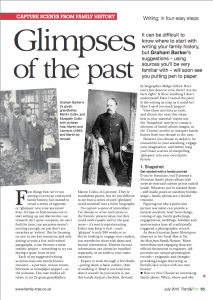Glimpses: How To Capture Scenes From Your Family History
At this stage, we’re not aiming to write an end-to-end family history, but instead to create a series of vignettes or ‘glimpses’ into your ancestors’ lives.
It’s easy for we family historians to find excuses not to start writing up our discoveries: our research isn’t quite complete, we can’t find the time, our ancestors weren’t exciting enough, we just don’t see ourselves as ‘writers’. But by focusing on one or two key resources, and only aiming to write a few, well-crafted paragraphs, it can become a more realistic project – something to try out during a spare hour or two.
Each of these suggested writing activities uses one family history resource – a portrait, census return, heirloom or newspaper snippet – as the stimulus. Each is illustrated with one or two examples – they’re standalone pieces, but it’s not difficult to see how a series of such ‘glimpses’ could snowball into a fuller biography.
Snapshot: get started with a family portrait
Heirloom: take inspiration from a handed-down family item
Census: re-create a sense of time and place
In the News: re-imagining a family event
Keep it brief and vital – each ‘glimpse’ is only 200 words or so. You’re looking to engage your readers, not overwhelm them with dates and factual information.
Certainly do your detailed research, but then corral it carefully; there’s no need to shoe-horn everything into it. Your aim is to let the narrative flow, and convey a sense of time and place. Heavier factual information can always be bundled separately, as an aside to your main narrative.
Expect to work through a few drafts – jotting down a basic outline, then re-working it a couple of times. Read it out loud, how does it sound? As you review it, use this handy six-part checklist, devised by biographer Midge Gillies: Does every fact deserve to be there? Are my facts right? Is there anything I don’t understand? Have I varied the pace? Is the writing as crisp as it could be? Have I used too much jargon?
View these activities as tools, and choose the ones that relate best to your research material: maybe use the ‘Snapshots’ activity to curate a selection of family album images; use the ‘Census’ activity to interpret family homes from one decade to the next; try out all four activities to capture the stories of a more colourful ancestor.
 However, you choose to tackle it, remember these salient words from family biographer, Blake Morrison: “The history of someone else’s family is as tedious as a holiday slide show – unless it is well told.” Be resourceful in your searching, engage your imagination, and before long you’ll have a series of compelling ‘glimpses’ into your own family history.
However, you choose to tackle it, remember these salient words from family biographer, Blake Morrison: “The history of someone else’s family is as tedious as a holiday slide show – unless it is well told.” Be resourceful in your searching, engage your imagination, and before long you’ll have a series of compelling ‘glimpses’ into your own family history.
Adapted from our article in Family Tree magazine: click to download the full article.
